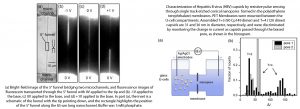In addition to developing sophisticated microscale
analysis systems, of particular interest is how device function scales when one or more of the conduit dimensions is on a nanometer length scale, and what advantages, if any, there might be for separations. nanofluidic systems can be significantly influenced by phenomena such as double layer overlap, surface charge, diffusion, and entropic forces, which are either insignificant or absent in larger microchannels. To develop analytical functions from these unique nanofluidic phenomena, we are studying fundamental fluid and material trasport and applying what is learned to separation and sensing problems, e.g., creating turnable particle/molecular filters and monitoring supramolecular assembly. Presently, we are developing electronic equivalent of nanofluidic devices and planar multi-pore devices which will be used towards sensing of particles such as viruses.


